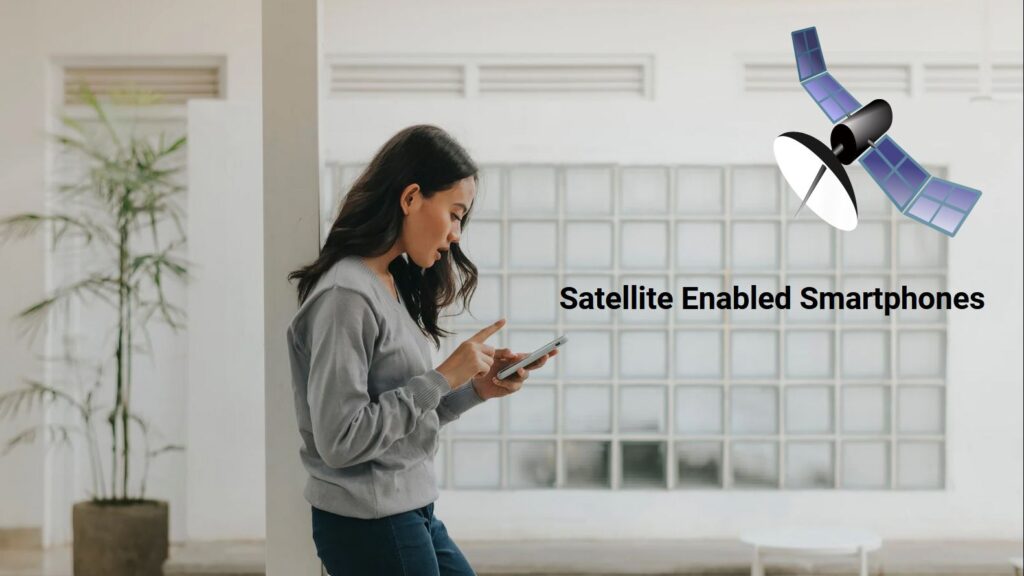The evolution of smartphones has reached a new milestone with the integration of satellite technology. Satellite-enabled smartphones are changing the way we communicate by offering connectivity even in the most remote locations. Unlike traditional mobile networks, which rely on cell towers, these smartphones connect directly to satellites orbiting Earth, ensuring uninterrupted communication.
In recent years, the demand for always-on connectivity has increased. Natural disasters, rural living, and adventurous travel often leave people in areas with weak or no network coverage. Satellite-enabled smartphones address these gaps, providing a reliable lifeline when conventional networks fail. As technology advances, more companies are investing in this innovation, making it a defining trend for the future of mobile communication.
How Satellite-Enabled Smartphones Work?
Satellite-enabled smartphones use space-based communication instead of relying solely on ground-based cell towers. Traditional mobile networks transmit signals between towers, limiting coverage to specific areas. In contrast, satellite communication uses orbiting satellites to relay signals directly to devices, allowing connectivity in remote and underserved regions.
Low Earth Orbit (LEO) satellites play a crucial role in this technology. Unlike geostationary satellites positioned 36,000 kilometers above Earth, LEO satellites operate at a much lower altitude (between 500 and 2,000 kilometers). This proximity enables faster data transmission and lower latency, improving call quality and internet speeds.
Most satellite-enabled smartphones use a hybrid approach, combining traditional cellular networks with satellite connectivity. When a user is within network coverage, the phone operates normally. However, in areas without coverage, the device automatically switches to satellite mode, allowing basic communication services like text messaging and emergency calls.
Leading Companies and Innovations
Several tech giants and telecommunications companies are driving the development of satellite-enabled smartphones. Each company is taking a unique approach to this innovation, aiming to revolutionize global connectivity.
- Apple: Apple introduced satellite-based emergency SOS with the iPhone 14 series, allowing users to send emergency messages when they are outside cellular coverage. This service has already helped save lives, and Apple is expected to expand its satellite capabilities in future iPhone models.
- SpaceX’s Starlink: Elon Musk’s Starlink project is a major player in satellite communications. Originally designed to provide global internet access, Starlink is now working with mobile carriers to bring direct satellite connectivity to smartphones. This will eliminate dead zones worldwide and offer real-time satellite-based mobile communication.
- Qualcomm’s Snapdragon Satellite: Qualcomm has partnered with Iridium to bring satellite communication to Android smartphones. This technology, expected to roll out in premium Android devices, will offer emergency messaging and potentially expand to broader communication services in the future.
- Other Players: Companies like AST SpaceMobile and Lynk Global are also making significant advancements in satellite-to-mobile technology. These startups aim to provide direct satellite connectivity to unmodified smartphones, eliminating the need for specialized hardware.
Key Benefits of Satellite Connectivity in Smartphones
The introduction of satellite-enabled smartphones comes with several advantages that enhance connectivity, safety, and reliability.
- Global Coverage: No More Dead Zones
Satellite-enabled smartphones offer seamless connectivity in areas where traditional networks are unavailable. Whether in deserts, mountains, or oceans, users can stay connected regardless of their location. This is a game-changer for travelers, explorers, and those living in rural areas with poor network infrastructure. - Emergency SOS Services in Remote Areas
One of the most significant benefits of satellite-enabled smartphones is their ability to send emergency messages when no cellular network is available. In cases of accidents, natural disasters, or lost hikers, these devices can establish a direct link with emergency responders, increasing the chances of timely rescue. - Improved Reliability During Natural Disasters
Traditional cell towers can be destroyed or disabled during hurricanes, earthquakes, and other disasters, leaving affected areas without communication. Satellite-enabled smartphones ensure that people can reach emergency services, coordinate rescues, and stay informed, even in the most challenging conditions. - Expanding Connectivity in Developing Regions
Many regions worldwide lack the infrastructure needed for reliable mobile networks. Satellite-enabled smartphones bridge this gap by providing access to essential communication services without requiring extensive investments in ground-based towers. This can revolutionize education, healthcare, and business opportunities in underdeveloped areas.
Challenges and Limitations
Despite their promising future, satellite-enabled smartphones face several challenges that need to be addressed before widespread adoption.
- High Costs of Satellite Services
Satellite connectivity requires expensive infrastructure, which often translates to higher costs for users. Currently, most satellite-enabled features are available only on premium smartphones, and the services require additional subscription fees. As competition increases, prices are expected to decrease, making the technology more accessible. - Battery and Hardware Limitations
Connecting to satellites consumes more power than using a traditional cellular network. Satellite-enabled smartphones must optimize battery efficiency to prevent excessive drain during satellite mode. Additionally, integrating satellite antennas into compact smartphone designs poses engineering challenges. - Regulatory and Spectrum Allocation Challenges
The use of satellite connectivity involves complex regulations and frequency spectrum allocations. Governments and regulatory bodies must coordinate to ensure seamless global communication without interference between different satellite networks. This process can slow down adoption in certain regions.
Future Trends and Predictions
The future of satellite-enabled smartphones looks promising, with several trends expected to shape the industry in the coming years.
- Greater Transparency on Satellite Usage
Future smartphones may include built-in tools to display their carbon footprint and satellite usage metrics. Users will be able to track how often their device switches to satellite mode and the environmental impact of such connections. - Expansion of 5G and Satellite Hybrid Networks
The integration of 5G and satellite networks will provide even faster and more reliable global connectivity. This hybrid approach will ensure that users experience seamless transitions between terrestrial and satellite networks without noticeable disruptions. - Direct-to-Smartphone Satellite Internet Services
Companies like Starlink and AST SpaceMobile are working on providing direct satellite internet to smartphones, eliminating the need for specialized ground equipment. In the future, users may access high-speed internet via satellites without relying on Wi-Fi or mobile networks. - AI and Machine Learning for Optimized Connectivity
Artificial intelligence (AI) will play a crucial role in optimizing satellite communication. Smart algorithms will manage bandwidth distribution, prioritize emergency messages, and reduce latency, making satellite-enabled smartphones more efficient and responsive.
Satellite-enabled smartphones are redefining the way we communicate by offering global connectivity, emergency support, and increased reliability in challenging environments. While challenges such as high costs and regulatory hurdles remain, advancements in technology and industry collaboration will drive wider adoption.
As more companies enter the market and competition grows, satellite connectivity will become a standard feature in future smartphones. This innovation will not only benefit travelers and emergency responders but also bridge the digital divide in undeserved regions. The future of mobile communication is shifting towards a world where connectivity knows no boundaries, ensuring that no one is ever truly out of reach.




